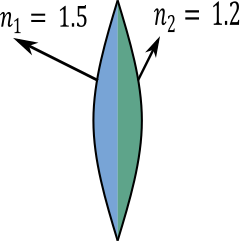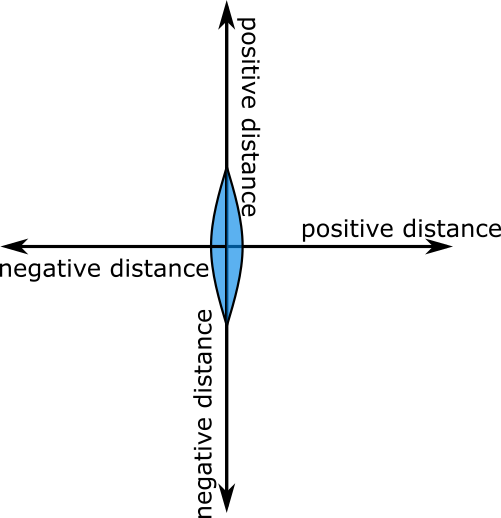
A bi-convex lens formed with two thin Plano-convex lenses as shown in the figure. Refractive index of the first lens is $1.5$ and that of the second lens is $1.2$ both the curved surfaces are of the same radius of curvature $R = 14cm$. For this bi-convex lens, for an object distance of $40cm$, the image distance will be.

A) $ - 280.0cm$
B) $40.0cm$
C) $21.5cm$
D) $13.3cm$
Answer
225.9k+ views
Hint: We want to find the final position of image for that we must have the focal length of lens only then we can find the position of image. To find the focal length of a lens although we have two Plano-convex lenses, we have to find the focal length of a combination of these Lens. When we find combined focal length then simply we apply lens formula to find the distance of the image.
Complete step by step solution:
In the question the given data is
Radius of curvature of both lanes $14cm$ and refractive index of lens 1is ${n_1} = 1.5$ and lens 2 is ${n_2} = 1.2$
Step 1:We have to find the individual focal length of both lenses by using formula.
$\dfrac{1}{f} = \left( {n - 1} \right)\left( {\dfrac{1}{{{R_1}}} - \dfrac{1}{{{R_2}}}} \right)$ ....................... (1)
Where $n \Rightarrow $ refractive index of lens
And ${R_1} \Rightarrow $ radius of curvature of first surface of lens
${R_2} \Rightarrow $ Radius of curvature of second surface of lens
$f \Rightarrow $ Focal length of lens
So we apply this formula for the first lens. For first lens

Refractive index ${n_1} = 1.5$
${R_1} = 14cm$
${R_2} = \infty $ Because second surface is plane in first lens
Apply formula from eq (1)
$ \Rightarrow \dfrac{1}{{{f_1}}} = \left( {1.5 - 1} \right)\left( {\dfrac{1}{{14}} - \dfrac{1}{\infty }} \right)$
$ \Rightarrow \dfrac{1}{{{f_1}}} = \left( {1.5 - 1} \right)\left( {\dfrac{1}{{14}}} \right)$
Solving it
$ \Rightarrow \dfrac{1}{{{f_1}}} = \dfrac{1}{{28}}$
So the focal length of lens 1
$\therefore {f_1} = 28cm$
Similarly we find the focal length of the second lens. For lens 2

Refractive index is ${n_2} = 1.2$
${R_1} = \infty $
${R_2} = - 14cm$ Because ${R_2}$ is in left side of optical canter (by sign convention we take left side distance negative in sign and take right side distance positive )
Apply formula from eq(1)
$ \Rightarrow \dfrac{1}{{{f_2}}} = \left( {1.2 - 1} \right)\left( {\dfrac{1}{\infty } - \dfrac{1}{{ - 14}}} \right)$
$ \Rightarrow \dfrac{1}{{{f_2}}} = \left( {1.2 - 1} \right)\left( {\dfrac{1}{{14}}} \right)$
Solving it
$ \Rightarrow \dfrac{1}{{{f_2}}} = \dfrac{1}{{70}}$
So focal length of lens 2
${f_2} = 70cm$
Step 2: In this step we find the focal length of combination of both lenses
We have formula for find equivalent focal length of two lenses is given as
$\dfrac{1}{{{f_{eq}}}} = \dfrac{1}{{{f_1}}} + \dfrac{1}{{{f_2}}}$
Using this formula
$ \Rightarrow \dfrac{1}{{{f_{eq}}}} = \dfrac{1}{{28}} + \dfrac{1}{{70}}$
Solving it
$ \Rightarrow \dfrac{1}{{{f_{eq}}}} = \dfrac{1}{{20}}$
So the equivalent focal length of these lenses
$\therefore {f_{eq}} = 20cm$
Step 3
Now we can find the distance of image by using lens formula
$\dfrac{1}{f} = \dfrac{1}{v} - \dfrac{1}{u}$
Where $u \Rightarrow $ Distance of object
And $v \Rightarrow $ Distance of image
$f \Rightarrow $ Focal length of lens
In question it is given $u = - 40cm$
$f = 20cm$
Simply apply above formula
$ \Rightarrow \dfrac{1}{{20}} = \dfrac{1}{v} - \dfrac{1}{{ - 40}}$
Rearranging it
$ \Rightarrow \dfrac{1}{v} = \dfrac{1}{{20}} - \dfrac{1}{{40}}$
On solving
$ \Rightarrow \dfrac{1}{v} = \dfrac{1}{{40}}$
So the distance of image is
$\therefore v = 40cm$ Right side of lens.
Option (B) is correct here.
Note: Some time we get confuse why some time some distances take positive and some take negative so the answer is we use sign convention to understand sign convention see the diagram

We take all distances positive in the right side of the lens and take negative in the left direction.Similarly, in positive y direction take positive height and in negative y direction take negative.
Complete step by step solution:
In the question the given data is
Radius of curvature of both lanes $14cm$ and refractive index of lens 1is ${n_1} = 1.5$ and lens 2 is ${n_2} = 1.2$
Step 1:We have to find the individual focal length of both lenses by using formula.
$\dfrac{1}{f} = \left( {n - 1} \right)\left( {\dfrac{1}{{{R_1}}} - \dfrac{1}{{{R_2}}}} \right)$ ....................... (1)
Where $n \Rightarrow $ refractive index of lens
And ${R_1} \Rightarrow $ radius of curvature of first surface of lens
${R_2} \Rightarrow $ Radius of curvature of second surface of lens
$f \Rightarrow $ Focal length of lens
So we apply this formula for the first lens. For first lens

Refractive index ${n_1} = 1.5$
${R_1} = 14cm$
${R_2} = \infty $ Because second surface is plane in first lens
Apply formula from eq (1)
$ \Rightarrow \dfrac{1}{{{f_1}}} = \left( {1.5 - 1} \right)\left( {\dfrac{1}{{14}} - \dfrac{1}{\infty }} \right)$
$ \Rightarrow \dfrac{1}{{{f_1}}} = \left( {1.5 - 1} \right)\left( {\dfrac{1}{{14}}} \right)$
Solving it
$ \Rightarrow \dfrac{1}{{{f_1}}} = \dfrac{1}{{28}}$
So the focal length of lens 1
$\therefore {f_1} = 28cm$
Similarly we find the focal length of the second lens. For lens 2

Refractive index is ${n_2} = 1.2$
${R_1} = \infty $
${R_2} = - 14cm$ Because ${R_2}$ is in left side of optical canter (by sign convention we take left side distance negative in sign and take right side distance positive )
Apply formula from eq(1)
$ \Rightarrow \dfrac{1}{{{f_2}}} = \left( {1.2 - 1} \right)\left( {\dfrac{1}{\infty } - \dfrac{1}{{ - 14}}} \right)$
$ \Rightarrow \dfrac{1}{{{f_2}}} = \left( {1.2 - 1} \right)\left( {\dfrac{1}{{14}}} \right)$
Solving it
$ \Rightarrow \dfrac{1}{{{f_2}}} = \dfrac{1}{{70}}$
So focal length of lens 2
${f_2} = 70cm$
Step 2: In this step we find the focal length of combination of both lenses
We have formula for find equivalent focal length of two lenses is given as
$\dfrac{1}{{{f_{eq}}}} = \dfrac{1}{{{f_1}}} + \dfrac{1}{{{f_2}}}$
Using this formula
$ \Rightarrow \dfrac{1}{{{f_{eq}}}} = \dfrac{1}{{28}} + \dfrac{1}{{70}}$
Solving it
$ \Rightarrow \dfrac{1}{{{f_{eq}}}} = \dfrac{1}{{20}}$
So the equivalent focal length of these lenses
$\therefore {f_{eq}} = 20cm$
Step 3
Now we can find the distance of image by using lens formula
$\dfrac{1}{f} = \dfrac{1}{v} - \dfrac{1}{u}$
Where $u \Rightarrow $ Distance of object
And $v \Rightarrow $ Distance of image
$f \Rightarrow $ Focal length of lens
In question it is given $u = - 40cm$
$f = 20cm$
Simply apply above formula
$ \Rightarrow \dfrac{1}{{20}} = \dfrac{1}{v} - \dfrac{1}{{ - 40}}$
Rearranging it
$ \Rightarrow \dfrac{1}{v} = \dfrac{1}{{20}} - \dfrac{1}{{40}}$
On solving
$ \Rightarrow \dfrac{1}{v} = \dfrac{1}{{40}}$
So the distance of image is
$\therefore v = 40cm$ Right side of lens.
Option (B) is correct here.
Note: Some time we get confuse why some time some distances take positive and some take negative so the answer is we use sign convention to understand sign convention see the diagram

We take all distances positive in the right side of the lens and take negative in the left direction.Similarly, in positive y direction take positive height and in negative y direction take negative.
Recently Updated Pages
JEE Main 2025-26 Experimental Skills Mock Test – Free Practice

JEE Main 2025-26: Magnetic Effects of Current & Magnetism Mock Test

JEE Main 2025-26 Atoms and Nuclei Mock Test – Free Practice Online

JEE Main Mock Test 2025-26: Optics Chapter Practice Online

The work done in slowly moving an electron of charge class 12 physics JEE_Main

The value of the resistor RS needed in the DC voltage class 12 physics JEE_Main

Trending doubts
JEE Main 2026: City Intimation Slip and Exam Dates Released, Application Form Closed, Syllabus & Eligibility

JEE Main 2026 Application Login: Direct Link, Registration, Form Fill, and Steps

Understanding the Angle of Deviation in a Prism

Hybridisation in Chemistry – Concept, Types & Applications

How to Convert a Galvanometer into an Ammeter or Voltmeter

Ideal and Non-Ideal Solutions Explained for Class 12 Chemistry

Other Pages
JEE Advanced Marks vs Ranks 2025: Understanding Category-wise Qualifying Marks and Previous Year Cut-offs

Dual Nature of Radiation and Matter Class 12 Physics Chapter 11 CBSE Notes - 2025-26

Understanding Atomic Structure for Beginners

Understanding Average and RMS Value in Electrical Circuits

Degree of Dissociation: Meaning, Formula, Calculation & Uses

Gyroscope Explained: Principles, Working & Real-World Uses




